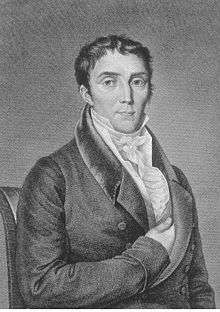José Joaquín de Ferrer
| José Joaquín de Ferrer | |
|---|---|
 | |
| Born |
October 26, 1763 Pasajes, Guipúzcoa, Spain |
| Died |
May 18, 1818 (aged 54) Bilbao, Spain |
| Scientific career | |
| Fields | Astronomy, cartography, navigation and mathematics |
José Joaquín de Ferrer y Cafranga (Pasaia, October 26, 1763 – Bilbao, May 18, 1818) was a Spanish Basque astronomer.
In 1779, aged 17, he was onboard the Gipuzcoana Company's Nuestra Señora de la Asunción off Cape St Vincent when the vessel was captured by the British. After surviving captivity with the help of his family, he undertook studies.
The Spanish astronomer was part of the first solar eclipse expeditions. He journeyed to Cuba in 1803 and to New York State in 1806 and observed the two solar eclipses successfully. In the description of the solar eclipse in 1806 observed from Kinderhook, New York he coined the word corona[1] for the bright ring observable during a total eclipse.[2][3]
References
- ↑ American Philosophical Society (1809). Transactions of the American Philosophical Society. 6. The Society. p. 264.
- ↑ "SECalendar" (PDF). Solar Eclipse Newsletter. NASA. 9 (6). June 2004.
- ↑ Alcalá Galiano, Antonio (1858). Biografía del astrónomo español Don José Joaquín de Ferrer y Cafranga. J. Martin Alegria. p. 49.
Further reading
- Dunbar, William; Hunter, George; Berry, Trey; Beasley, Pam; Clements, Jeanne (2006). The forgotten expedition, 1804-1805: the Louisiana Purchase journals of Dunbar and Hunter. ISBN 978-0-8071-3165-7.
- "Total Eclipses of the Sun, Historical Eclipses and Earth's Rotation".
- "image".
- "JOSÉ JOAQUÍN FERRER" (PDF).
- "Joaquín Ferrer y Cafranga".
- "Biografía del astrónomo español Don José Joaquín de Ferrer y Cafranga / por Antonio de Alcalá Galiano".
This article is issued from
Wikipedia.
The text is licensed under Creative Commons - Attribution - Sharealike.
Additional terms may apply for the media files.